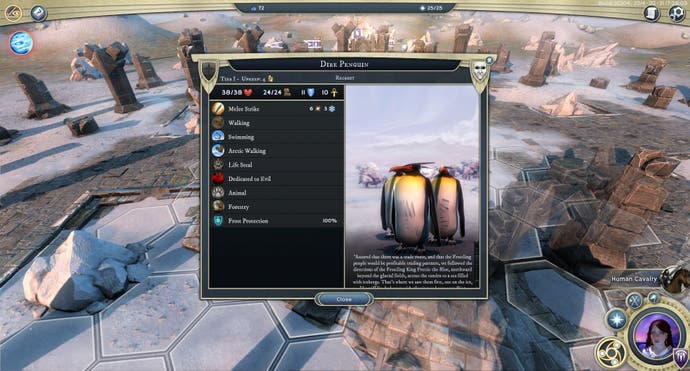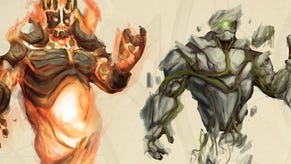Hi, fantasy: Exploring the world of Age of Wonders 3
The magical mystery tour.
It's sparkly. It's really sparkly. And it has giant penguins.
I need to get those things out the way now. I'm quietly optimistic about Age of Wonders 3 and after having spent some lovely evenings amidst its shimmering spires, creaking forests and flitting faeries, I've very much enjoyed myself, but I must make it clear to you that it's a little bit silly.
I suppose all high fantasy is a little bit silly, and the higher it gets, the sillier it becomes. Though I haven't yet found flocks of giant moths, walking castles or a school for wizards, Age of Wonders 3 is the sort of game that has me thinking I still might, and perhaps very soon.
It's full of things. It has all of the things. It has maps resplendent with strange magical decoration, from mysterious ruins to esoteric shrines to glowing magical nodes, sometimes so close together that you stumble out of one and straight into the other. Its strange locales are populated by wisps and trolls and goblin scoundrels. Some of its creatures are beyond bizarre, such as the cherubs that look more like naked aliens, while the leaders it offers you as avatars embody every genre stereotype you'd expect. There's a particularly peculiar opulence to its excess, something that feels closer to Liberace than Tolkien.

Whichever of its leaders you select, it's their the boots that you shoehorn yourself into as Age of Wonders appoints you as both the military and political leader of one of its factions, making you a sort of high elven Fidel Castro or an orcish Oliver Cromwell. All economics, all diplomacy, all strategic decisions, even the command of every single battle fought falls within your purview. Your task, of course, is to spread your empire across the land, expanding your influence through gentle negotiation or by rampant, naked aggression.
That means it's no great departure for the series and Age of Wonders 3 is certainly feeling like a familiar sequel, even if it has been souped-up. That's no bad thing and, for many of us a grander, prettier sequel is going to be exactly what the witch doctor ordered. We've been going cold turkey for over a decade now, with the last Age of Wonders game released in the summer of 2003, a time before YouTube, before Steam, even before Justin Bieber. This is a series that has been sorely missed.
It's reborn in a mould very similar to that of a game it part inspired, Warlock, which itself took cues from the interface and hex-based worlds of Civilization 5. One corner of the screen holds a map, above which gentle prompts remind you of whatever tasks demand your ruler's attention, while your cities birth armies that then conquer more cities, broadening your borders and bringing even more of the realm's many magical curiosities into your fold.
All the while, you diligently research new spells to use both on and off the field of battle, as well as carefully improving your cities and occasionally recruiting new heroes to lead your ever-growing forces. That's the idea, anyway, but since all the other factions about the land are trying the same thing, it's inevitable that toes will be stepped on. A little diplomacy could make you a new friend or even forge an alliance, but sooner or later the forecast will be war and the sky will rain arrows.

Don't let all the sparkle of the world map assuage you. When battle is joined, things get brutal. Age of Wonders 3 takes you into a tactical mode where an aggressive and opportunistic AI takes advantage of all sorts of battlefield bonuses and tries every trick in the book. There's flanking to consider, where attacking units from the side or behind grants a plus, or the disadvantage of assaulting a prepared unit. Archers who don't move can fire multiple, punishing volleys and horrible, wicked spells can weaken enemy units or give tremendous advantage to your own.
It's a well-developed system and it's not at all easy to master, particularly when sieges occur. Units trying to smash down gates are funnelled into killing zones, while archers struggle to fire at defenders crouched on city walls. Again, the AI has a good grasp of how to make the most of its advantages here and, after a few battles, so too will you.
If captaining each combat isn't to your liking, there's the usual auto-resolve options, but these battles are a big part of the game and they're your chance to try out whatever esoteric creatures your armies have gradually amalgamated. Unicorns, it turns out, make fine cavalry, while giant eagles provide much-needed air support. There's a lot of scope for army customisation, mixing and matching forces to suit your preference or create deadly troop combinations, but each army is limited to just six units. You can be picky, but you can't be excessive.
Learning which unit combinations are most effective (and where) is going to take time, but just as valuable as the right troops are the best troops. In time, and should you keep them alive, all your units can gain experience, hardening themselves against the slings and arrows of outrageous elves. Your generals can also gain levels, each step up giving you the option of buying from a host of special abilities that do everything from increasing their movement to improving their siege ability.

If there's a lot to consider on the battlefield, so far there seems to be less calling for your attention in the council chamber. Diplomacy is not looking as developed or distinct and consists of the standard trade, gifting and alliance options. Certain political choices affect your faction's alignment and, in time, this will start to define you in the eyes of other rulers, particularly those leading the many neutral and independent settlements that speckle the world. It's these you'll meet first and, as you expand, it's your choice whether to bribe, negotiate with or conquer these factions. It's usually your decisions here that set the tone for the rest of the map.
As well as a couple of pre-made scenarios and a map generator, Age of Wonders 3 also features a campaign that, I concede, certainly may improve with time, but which kicks off with the most generic tale of interfaction fantasy warfare possible (something, I should add, which is far less interesting than the game's real world story, that of a beloved series which we will finally see revisited thanks to contribution of Notch). I imagine that many players will want to leap into random map generation and explore world after world, but an editor will also provide the option for building your own and adding in scripted events that create new scenarios or even custom campaigns. If you don't like the tales being told, you can always write your own.
Age of Wonders 3 looks to be coming along very nicely indeed, offering a vision of fantasy as broad as it is high. Yes, I suppose it all might be a rather overblown affair, but it's trying to be so big and to offer so much that I can only admire its ambition. And its penguins.






